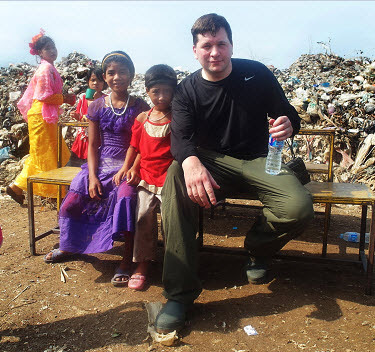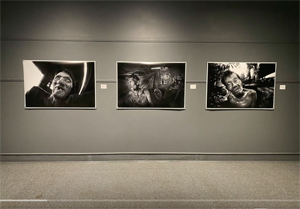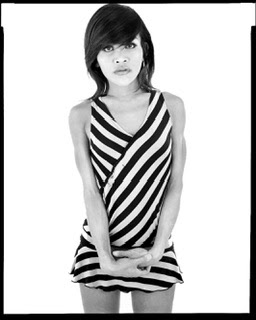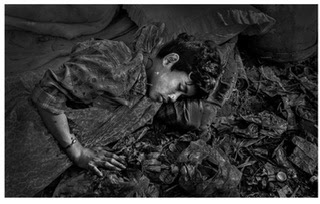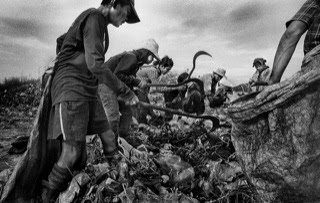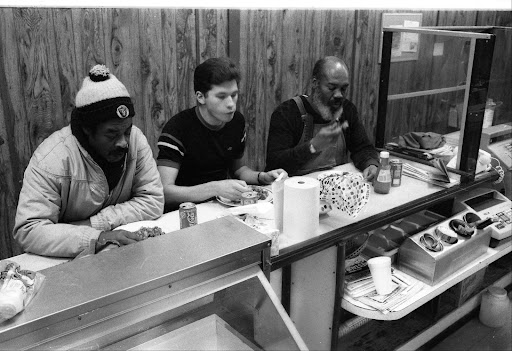
A Moment With Diane Arbus Created A Lasting Impression
By David Segal
Washington Post Staff Writer
Thursday, May 12, 2005; C01
NEW YORK They remember none of it. Not the lady with the camera, arranging them by a wall at the Knights of Columbus hall in their home town of Roselle, N.J. Not the chocolate cake they had just finished, which is very faintly visible in the picture at the creases of their lips. The Wade sisters, as they were known before they each married, recall nothing about the day they gazed into the lens of Diane Arbus and became part of American photographic history. Unless you count the dresses.
"We still have them," says Colleen.
"Our mother made them," says Cathleen. "They look black in the photograph but they're actually green."
They were 7 years old in 1967, when Arbus found the girls at a Christmas party for local twins and triplets. Nobody is quite sure how Arbus heard about the gathering, but a few parents obliged when she asked their children to pose. Which is how the Wade sisters wound up on a sidewalk, standing close enough to seem joined at the shoulder, their expression a kind of spectral blank.
It would become one of the most famous photographs of the era's most compelling photographer. Arbus killed herself in 1971, at the age of 48, leaving behind a gallery of characters -- some of them spooky, some of them bizarre, all of them vaguely tragic -- who won't go away. There's a retrospective of her work called "Revelations" now on view at the Metropolitan Museum of Art and it's a menagerie of weirdos we seem to have known all our lives: those two men waltzing at a drag ball, that Mexican dwarf, the grimacing kid with a toy grenade.
They've been handed a peculiar kind of celebrity, the kind you don't ask for and certainly don't expect. One day you're minding your business, the next day you're immortalized in perpetuity beside "Nudist lady with swan sunglasses, Pa. 1965," or "Transvestite at a drag ball, N.Y.C. 1970."
What's it like to land in this hallowed collection of "freaks," as Arbus once referred to her subjects? It depends on which "freak" you ask, it turns out. The great recurring theme of Arbus's work is a sense of otherness, and if you talk to a few of her subjects you realize that in some cases she discovered that otherness in people and then committed it to film, and in other cases she somehow imposed it.
"We thought it was the worst likeness of the twins we'd ever seen," whispers Bob Wade, the girls' father. He and his daughters are visiting the Met exhibit one recent afternoon and at the moment are standing a few feet from "Identical twins, Roselle, N.J. 1967," the image that is clearly the star of this show. It's featured on the publicity photo and there's a bench nearby so visitors can sit and stare.
"I mean it resembles them," Wade continues. "But we've always been baffled that she made them look ghostly. None of the other pictures we have of them looks anything like this."
The Family Album
Tracking down the people Arbus photographed is tricky because the executors of her estate won't disclose the names of her subjects. But the identities of a few are known because they stepped forward at some point and said, "That's me." Others are known because Arbus for years had a lucrative sideline shooting family portraits, and some of those subjects have provided copies of the photos, along with their names, to museums.
That is why it's possible to identify Marcella Matthaei, who as an 11-year-old stood and glowered at Arbus in December of 1969, yielding a memorable study in a brooding adolescence. Marcella's mother had heard about the photographer through a friend who'd curated some high-profile museum shows, one of which included Arbus's work. In need of a professional for an annual family shoot, Gay Matthaei hired Arbus, which seems either bold or insane, depending on your point of view. But the Matthaeis were arty people, uninterested in conventional studio stuff, and Gay had seen the photo of the Wade sisters and thought it was a stunner.
"I really liked it," she says. "I'm an identical twin and I understood the photo she took of those little girls. I'd been posed with my twin my whole life."
Arbus snapped more than 300 photos that weekend, dressed in black and moving so unobtrusively around the house that the Matthaeis often forgot she was there.
"The only recollection I have of her is that I mistakenly thought she was Joan Baez," says Marcella, who lives in Florida now and describes herself as a part-time writer and part-time construction worker. "She was slender and pretty and my father had a Joan Baez album. I thought it was her."
The Matthaeis weren't anticipating Norman Rockwell results, of course, and that's not what they got. Arbus printed 50 of the photos, among them a striking portrait of Marcella, wearing a frilly sundress, her shoulders pulled back, her long bangs nearly shrouding the cryptically intense look in her eyes. It has the immediacy of a mug shot and you can't help but wonder what was going on in her mind at that moment. Is she fighting back tears? Deeply depressed?
Neither. "I was on my way to a party," she says. "I was interested in playing spin the bottle, and being put in a sundress with knee socks and sitting around with a stranger taking pictures of me was the last thing on my mind. What you see on my face is, 'Get this over and done with. My mom and dad told me to do this.' " At least Marcella knew she was being photographed. Other Arbus subjects had no idea. Like the infant in "A very young baby, N.Y.C. 1968," which ran in Harper's Bazaar and is now one of the images stopping the crowd at the Met. The baby's eyes are closed, lips a little drooly. One critic likened it to a death mask.
The weirdest part, it turns out, isn't what the infant looks like. It's who it is. It's Anderson Cooper. Yes, CNN anchorman Anderson Cooper.
"I have it in my bedroom," Cooper says by phone. "I think it's great."
The back story here is that Cooper's mom is Gloria Vanderbilt, the socialite turned denim jeans spokeswoman turned memoirist. She was married at the time to author Wyatt Emory Cooper, and she was friends with Arbus, who in 1968 was looking for babies to photograph for a series she was assembling. When Arbus sent the images to Harper's Bazaar, an editor called Vanderbilt with a question: Are you sure it's okay to put your son's name on this photo?
"They were worried that my mother might find the picture a little disturbing," says Cooper. "My mother was stunned." Publish his name, she told the magazine.
"I heard that Elton John sold me" -- by this he means a copy of "A very young baby" -- "at auction recently, and I was a little offended by that, frankly," Cooper says, laughing. He realizes why some might find the image unsettling, but he's amused by it and kind of thrilled to be in a museum.
His one request: "Just make it really clear to people that I'm not the kid with the grenade."
He's not the kid with the grenade. That would be Colin Wood, who is now 50 years old and an insurance agent living in Glendale, Calif. Wood has no memory of running into Arbus, which he did in Central Park one afternoon when he was 7. But he remembers that H.M.S. Pinafore outfit, and he recalls the type of toy grenade he is clutching so spasmodically in that picture. As fake weapons go, he recalls they were pretty annoying because they'd pop almost as soon as you threw them. "You couldn't throw it somewhere and duck," he says. "It blew up about a foot away."
Look at the other shots of Wood in that roll, which are included in the book version of "Revelations," and he comes across as a fairly typical kid, mugging for the camera. His guess is that he was out with his nanny when Arbus spotted him and after a few shots, he'd had enough. Or perhaps Arbus goaded him to give her something more.
"I'm sure that photo was a collaboration," he says. "I didn't pose like that unless asked. I think I was imitating a face I'd seen in war movies, which I loved watching at the time."
Wood says he was a hyperactive child, and there's a slightly manic pace to his speech today. He talks fast, rarely pausing. He first learned of his notoriety, he explains, when he was 14, after his stepsister spotted the image in a book. His first thought was something close to "Big deal." Then a classmate at his Rhode Island prep school found a copy and, as a practical joke, posted Xeroxes of the picture all over campus. Wood was mortified.
"He hated it, hated the whole thing," recalls Tim Ghriskey, who knew Wood in his prep school days. "We were all teenagers and none of us wanted notoriety, none of us wanted to stick out."
Wood's own feelings about the photo have evolved. He remembers feeling angry at Arbus for "making fun of a skinny kid with a sailor suit." But today he thinks of the image as one of the great conversation pieces of all time. And Arbus clearly fascinates him. He riffs about her for a good 15 minutes.
"She catches me in a moment of exasperation. It's true, I was exasperated. My parents had divorced and there was a general feeling of loneliness, a sense of being abandoned. I was just exploding. She saw that and it's like . . . commiseration. She captured the loneliness of everyone. It's all people who want to connect but don't know how to connect. And I think that's how she felt about herself. She felt damaged and she hoped that by wallowing in that feeling, through photography, she could transcend herself."
Wood remembers that his interest in guns and grenades prompted teachers at his Catholic grade school to suggest he see a shrink. ("They thought I was deranged" is how he puts it.) His father dismissed the idea. Wood ended up working for years with his father, a former professional tennis player who invented, and for a long time installed, a new kind of court surface. Wood tried a few different careers after that and eventually moved to Los Angeles to try his hand at acting. He found the auditioning process humiliating and he quit. Now he sells insurance.
He doesn't talk often about his cameo with Diane Arbus but it's been a long time since he was embarrassed about it. Once he wanted to break into theater, and when he started his own production company he knew what to call it: Grenade Boy Productions.
Hey, That's Them!
There's a gift shop near the Arbus show at the Met, and by the time the Wade sisters get there on Saturday afternoon, people have figured out who they are. Maybe it's their eyes, which are still a startling bright blue and appear in the photograph to be glowing. Or maybe it's their lime-green jackets and black slacks, nearly matching outfits that shout their twinness. A cashier notices them first, then others ask them to sign their posters. The most forward want them to pose for a picture.
"No flash photos in here, please," says a Met guard, breaking up the crowd.
You can understand the hubbub. Arbus's subjects seem to exist in another dimension, in some unreachable place where they are stranded and will never be seen again. She gave these two an otherworldly aura, as if they'd just stepped out of a fairy tale and are about to start fires with their minds. The director Stanley Kubrick paid homage to this mix of innocence and menace in "The Shining." Twin girls, side by side and in matching dresses, turn up as ghosts in the film, harbingers of a gory finale. It's utterly terrifying.
"I've never seen that movie," says Cathleen. "I've heard it was scary and I don't like scary movies."
The mystery of "Identical twins, Roselle, N.J. 1967" only deepens when you meet the Wade sisters, who are the least creepy people you'll ever know. By their own accounts, they have lived rather conventional lives and today they are both married, both working mothers, still very close and still a little shy. They're amused by this photo, maybe a little proud of it, too. But they have never reflected on it much and, pressed with questions like "Does this capture something about you?" or "Can you remember being this little girl?" they just shrug.
"It reminds me of my daughter," says Cathleen.
What Arbus has given us with this photo is ultimately a Sphinx without a riddle. Or maybe there's a riddle here, but it belongs to Arbus. And she isn't telling.
"Somebody called me and told me the twins were on the cover of the Village Voice," their dad says, shaking his head as the troupe heads for the exits. Bob Wade is describing the day he learned about "Identical twins." This was in 1972, to the best of his recollection, as the Museum of Modern Art put together an Arbus exhibit. "I told my wife, 'I didn't sign anything.' She said, 'Uh, I did.' "
Which is a good thing. A copy of "Identical twins" sold last year for nearly $500,000 and when Diane Arbus mailed the Wades that release form, she sent along something else: an original print of the photo.
"I've stashed that one away," Wade says, grinning. Then he nods toward his daughters. "That's their 401(k)."










